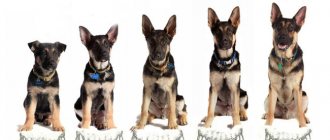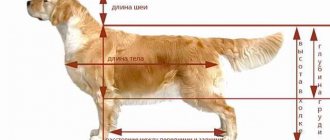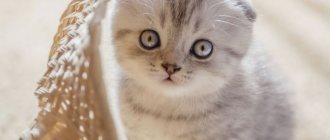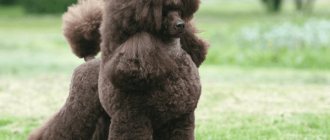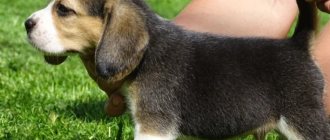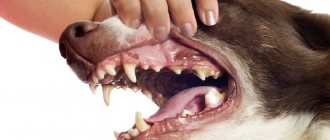The Samoyed is a fairly large dog, characterized by endurance and unpretentiousness.
The high activity and energy of these animals, as well as their fairly light bones, create all the prerequisites for them to weigh somewhat less than representatives of other large breeds.
What should be the size and weight of an adult Samoyed and how do they change during the first months of the pet’s life?
And what should you do if the weight of a puppy or young dog is not normal?
Breed standard and what it looks like in the photo
A purebred Samoyed dog must meet the following parameters :
- Head : The skull is slightly convex and wide. The head is massive, wedge-shaped.
- Muzzle : neat, gently tapering towards the nose, lips dense, fleshy, fitting tightly to the jaw. Jaws : strong, regular, scissor bite.
- Nose : black and wide. The nostrils are large and open. Must be outlined with a dark border.
Depending on the weather, the color of the Samoyed's nose may change and become less saturated..
- Eyes : dark brown, slanted, widely set, surrounded by a black rim. Due to this, the illusion of a “smiling” good-natured look is created.
- Ears : Triangular, small and erect with rounded tips. The cartilage is thick but soft.
- Neck : Gracefully arched, medium length. Due to the wool collar it seems quite powerful.
- Body : The body is strong, flexible and compact, exceeding the height at the withers.
- Legs : Muscular, strong and straight. More developed muscles are noticeable on the hind legs. A protective fluff grows between the fingers.
- Tail : when moving, curled over the back or side, in a calm state it is lowered to the hock joints. Set high.
- Coat : dense, thick, soft, shiny and long. Does not have a characteristic “dog” smell. The guard hair is straight and dense, the undercoat is thinner and denser. A fluffy collar forms around the neck. The hair on the head is very short, but even. On the hips it resembles bloomers
Samoyed wool is hypoallergenic, which is especially important for people prone to allergic reactions.
Samoyed training and education
Training and education of the Samoyed is complicated by the independence to which representatives of the breed have become accustomed over many centuries. The lifestyle of Samoyed dogs meant frequent independent decision-making. Samoyeds have retained this quality even now. Only now trainers call it stubbornness.
The specificity of upbringing lies in the fact that the Samoyed is a pack dog, and regards the family as a pack. From the first days of the puppy's appearance, it is necessary to let him understand who the leader of this pack is. Having accepted the proposed state of affairs, he will perceive new knowledge and rules with great zeal.
Hierarchy also has external signs that may seem humiliating to a person, but are perceived by a dog as the norm.
- The leader of the pack is the first to approach the food. It is better to feed the Samoyed after all family members have eaten.
- The leader goes first. You must not let the dog pass in front of you when opening the door.
- Decisions are made by the leader and authoritative members of the pack. The presence of a dog nearby must be allowed, and without permission the Samoyed must remain in its place.
Physical violence and rudeness should not be tolerated towards Samoyeds. This does not negate the need for punishment in case of misconduct. But the methods will have to be used the same as in a real flock. The dog needs to be lifted, holding it by the withers, shaken and its muzzle pressed to the floor. This will not cause pain, but will let the pet know that he is wrong.
Training a Samoyed puppy should begin at 3 months.
Training at home is possible. The owner can teach the Samoyed simple commands on his own. This will require patience and persistence. More complex training is best left to a professional trainer. He will conduct classes focusing on the character and temperament of the dog, and the characteristics of the breed.
Character and temperament
As the breeders assure, Samoyeds have an exceptionally pleasant character: it is easy to get along with them and find a common language.
Let's highlight the main distinctive features:
- Kindness : The Samoyed is overly affectionate and friendly. He can find an approach to any family member, including very young children. He is not characterized by aggression or hunting instinct, so he easily gets along with other animals. Due to its highly social adaptation, the dog is not at all suitable for protection.
- Trainability : The Samoyed loves to exercise. He likes to please and please his master, although sometimes he can be stubborn in order to test the “limits of what is permitted.” The fox dog is smart and cunning, has a good sense of mood and knows how to manipulate.
- Loyalty : very attached to all members of his family, but only one is chosen as the “leader of the pack”. For this reason, dog experts do not recommend getting an adult dog.
- Contact : loves to be the center of attention. Loves to lick people and jump into people's arms to show affection. For this reason, they should not be left alone for long. Ideally, at least one family member will be at home on a permanent basis. Otherwise, the Samoyed will begin to get nervous and worry about his loved one and “chew” his stress with furniture or shoes. This breed is definitely not suitable for people who are too busy.
- Energy : This is a very active and lively dog that simply needs to walk for several hours in the fresh air. In addition, Samoyeds are adapted to life on the street, but for harmonious development they need a large space. A kennel or chain harness will not work - you need a spacious enclosure.
- Endurance . This point directly follows from the previous one. Samoyeds can play tirelessly for several hours, so the future owner needs to review his daily schedule in advance and purchase a sufficient number of toys.
- Talkativeness . Samoyeds love to communicate with their owner and love the sound of their own voice even more. That is why they accompany each of their actions with a characteristic guttural whine or short bark.
- Love of life : they do not lose their puppyish delight, adventurism and thirst for adventure until old age.
Care and maintenance
Eat, eat, eat!
When purchasing a Samoyed dog, ask the breeder about how the baby ate. Try to follow the stated diet and feeding schedule as much as possible until the dog gets used to its new environment. Transfer your dog to the planned diet gradually - this will relieve digestive problems.
The decision on what kind of food - dry or natural - to feed the animal is made by the owner. It is advisable that factory-made feed belong to the premium category or higher. They contain all the necessary ingredients for normal development in balanced proportions. It is possible to create a complete diet from natural products, but this involves additional hassle, for which owners sometimes simply do not have time.
Even using ready-made food, it is useful to introduce fish dishes into the diet of a growing Samoyed, which he (unlike other dogs) loves very much.
Northern dogs also enjoy eating cottage cheese, which should be part of the daily menu. It is better to give it in the morning and make sure that the fat content of the product does not exceed 18%.
Don’t forget to add vitamins to your diet for coat and proper bone formation.
The snow-white luxurious Samoyed coat is a source of special pride for the breed. It does not get wet from snow or rain, and has an amazing ability to self-clean due to the presence of natural oils. Frequent bathing can impair this remarkable ability and may also cause your dog to develop skin problems or colds. The exception is paws, which need to be washed after every walk. The frequency of “bath” procedures for Samoyeds is 1-2 times a year. Exhibition animals are bathed more often and only with the use of professional shampoos designed for this type of coat.
So we met...
Protect the animal's eyes and ears from water and detergent getting into them. After bathing your pet, dry it with a towel, dry the fur with a hairdryer, while combing it in the direction opposite to growth.
Samoyed shedding
A dog's shedding will not cause you as much trouble as it would be logical to assume at first glance. Females shed twice a year, males only once. The process lasts no more than two weeks; the rest of the time the Samoyed dog does not lose hair at all. Systematic combing with special combs will reduce the shedding time. Another undeniable advantage of Arctic Spitz wool is that it is odorless.
The coat of a snow dog has excellent heat-insulating abilities, so Samoyeds can withstand not only extreme cold, but also heat. The only thing you absolutely cannot do is walk your pet under the scorching rays of the sun.
The size of the animal is not a problem for keeping in a city apartment. Determine a permanent place for the Samoyed in a cooler part of your home. The litter should not be soft and kept clean. It is desirable that from its place the Samoyed husky can control all the events taking place in the house: as a member of the pack, it should be aware of what is happening.
Teeth care involves brushing them weekly with a special toothpaste. It is recommended to wipe the ears with a dry soft cloth once a month. Samoyed dogs do not have their nails trimmed; they get worn down during walks.
You need to walk your pet at least twice a day, each exercise lasting at least an hour. If possible, devote as much time as possible to physical activity and active games on weekends.
Oh, ant!
Yum Yum Yum
What varieties are there?
There are only two types of rock, which differ slightly in their structure:
- Bearish: short and powerful, stocky body, and wide skull. So named because of its resemblance to a teddy bear.
- Wolf: elongated, lean body, narrow skull. They look more graceful and fragile than their bear-type counterparts.
Main types of colors
White is the canonical color for the Samoyed.
Few people know, but the standard includes two more colors. Let's look at each in a little more detail :
- White . Looking at a white Samoyed, one would like to call it snow-white - its fur reflects sunlight and sparkles beautifully. This effect is created thanks to the translucent tips of the guard hairs.
- Cream . The wool has a pleasant, warm tint. A dog with this color looks attractive, but has much less chance at an exhibition than a snow-white individual.
- White with biscuit spots . The rarest color. The predominant mass of the fur is snow-white, and only some areas are chaotically colored in a pale, biscuit shade.
Yellowing of the Samoyed's white coat may be a sign of improper grooming , illness, or an excess of animal proteins in the dog's diet.
Sometimes black Samoyeds are also found, but this coat color is not recognized by the breed standard.
History of the Samoyed Laika breed
The Samoyed dog can rightfully boast of having one of the longest histories among dog breeds.
The formation of these Siberian huskies began a long time ago in the north of Russia - the Urals and Siberia.
There, in harsh climatic conditions, lived tribes of aborigines, to whom the Samoyeds owe their name, because a group of these ancient local residents was called Samoyeds.
Initially, the breed was called Belek .
Being nomads, local tribes had appropriate requirements for the dogs that accompanied them - their pets had to be hardy to pull sleighs through the snow, smart and attentive - to herd livestock, loyal and obedient - so that children could be left with them.
The thick coat of Samoyeds was also used by nomads - the dogs spent the night with their owners, warming them with their warmth.
Photo 3. The Samoyed dog breed was formed in the Far North
In addition to Samoyed dogs, Alaskan Malamutes and Siberian Huskies, two of the most popular sled dog breeds in the world, were also universal human helpers in the North.
However, Samoyeds, who were more disciplined and quick-witted, also showed themselves to be more resilient Siberians, which is why they were used in the very first expeditions to the North Pole.
Samoyeds perfectly met all of the above requirements, which is why they gained their popularity.
In 1889, the famous English dog handler Ernst-Kilburn Scott spent more than three months for scientific purposes with the Samoyeds, exploring the nature of the Far North.
Being a dog handler, he could not let the beautiful white dogs that served the local residents out of his sight.
The zoologist liked the dogs so much that he considered it necessary to take one pair with him. And so it happened.
A pair of Samoyed dogs taken from their historical homeland has since been considered the founder of the breed, because it was Scott and his wife who began active work on breeding these dogs.
The scientist, who already knew quite a lot about these Siberian dogs, became the founder of the Farmingham kennel, as well as the creator of a club for admirers of these four-legged dogs, which opened in 1909.
Around the same period, the first Samoyed Laika breed standard in its history was published.
The Samoyeds described in that standard have not changed at all over their centuries-long history.
Modern representatives of this breed are exactly the same as 100 years ago.
Moreover, scientists suggest that during its entire existence (about 3000 years) this breed has undergone virtually no significant changes, since Samoyeds have always lived in a small localized space.
The intelligence and charisma, easy-going, cheerful character and loyalty, as well as, of course, the beauty of Samoyed dogs ensured this breed a rapid increase in popularity around the world, and already in 1932 the first kennel for these dogs was organized and opened in Europe.
Boys and girls: what are the differences?
It is quite easy to distinguish a female from a male by two characteristics: collar and body type.
Males have a truly luxurious collar and, in general, the breed characteristics are more pronounced. Females have a more compact and graceful physique.
There are also behavioral differences.
NOTE!
For example, females are more suitable for family, calm people, as they have a more flexible disposition and love to spend time with children.
Males, on the contrary, gravitate towards active pastime and have a more independent disposition, which means he can become an excellent companion for an avid traveler.
Friend and Companion
Despite the fact that Samoyeds have been carried through centuries and even in modern conditions have perfectly preserved their working qualities and ability to work harmoniously in a team, they are not prone to aggression and in themselves are very friendly and mischievous dogs.
Activity is everything!
If suddenly sometimes it seems that something needs to be changed in life, that sometimes it’s too boring, just get a Samoyed. Even a person who is not inclined to lead an active lifestyle, such a dog will definitely drag him outside and force him to play with him.
And if you remember that these Siberians get along well with children, then a good nanny may appear in your social circle.
Photo 5. Samoyed huskies are kind and faithful friends
Regarding their attitude towards strangers, these dogs are akin to huskies and are extremely harmless to strangers.
This is a very good quality for a dog that will regularly meet new people, but this same character trait of Samoyed Laikas makes them very poor guards and watchmen.
If there are already other pets in the house, then the appearance of a Samoyed in their company will not cause any special problems. These dogs get along well with cats, and with other inhabitants too.
If we talk about dogs of other breeds, then this is also not a problem.
The Samoyed Laika is a breed whose formation took place in conditions of northern frosts and regular heavy loads, which the dog could only cope with together with other dogs.
Samoyeds are pack dogs, and therefore experts recommend having either several Samoyed dogs at once, or a Samoyed with representatives of other breeds.
This will make the dog more active and its working instincts will be much better.
A lonely dog of this breed can gradually lose its activity, become lethargic and lacking initiative.
Sometimes loneliness affects them in a completely different way: the dog can start running circles around the rooms for no reason, destroying everything in its path.
Appearance of puppies (photos)
The appearance of Samoyed puppies cannot leave anyone indifferent: they look like small polar bear cubs .
It is at the stage of choosing a puppy that many “lose their heads” and do not pay any attention to disqualifying signs, or, worse, signs of ill health.
What does development depend on?
The rate at which any puppy gains height and weight depends on several factors:
- Genetics. Heredity determines what kind of physique a dog will have in the future - massive or light. Also, the genetic factor determines how long the growth will last and when it will stop completely.
- Diseases. Diseases suffered at an early age leave an indelible mark on the dog’s future life. Thus, some infectious and viral diseases can significantly slow down the process of weight gain. And such severe pathologies as rickets completely stop the growth of puppies.
- Diet. Proper nutrition is the key to a healthy life for any living organism. For large dogs like Samoyeds, proper diet is extremely important. After all, if you feed your pet food that is inappropriate for it and do not add various minerals and vitamins, you may not expect the dog to grow big and strong.
- Physical development. Many owners believe that the more physical activity a dog gets, the better, but this is not true. If a puppy is overloaded with sports activities, it will do him more harm than good.
If the dog looks too thin, or, conversely, is overweight, you should seek help from a veterinarian. The specialist will tell you how to adjust your pet’s daily diet. The doctor will also be able to tell you what the dog’s physical activity should be.
Similar articles
How to choose?
Familiarize yourself with the characteristics of the breed in advance and, if possible, talk to real breeders. Measure your strengths - can you recreate favorable conditions for her upbringing and living?
If you answered yes to each of these questions, go to the nursery.
IMPORTANT!
A puppy should be adopted at the age of 6 months. It is then that all the features of the exterior appear.
Next, the most difficult stage awaits you - choosing a puppy.
Therefore, forcefully put aside tenderness and desires to take the first baby who ran up to your call and focus your attention on the following signs of health:
- Coat : It should be thick, shiny, clean and free of clumps. The hairs should not fall off when touched.
- Stool : take the time to wait until the puppies go to the toilet and pay attention to the shape of the stool - it should not be liquid. Also pay attention to the cleanliness of the fur around the anus.
- Eyes : normally they are clean, clear, without mucus in the tear ducts.
- Ears : clean, without odor and without redness, scratches or discharge.
- Activity : the puppy must be active and cheerful, slight “childish” clumsiness is acceptable.
To prevent moving to a new place from being too stressful for your puppy, prepare your home in advance: buy bedding with thick fabric to minimize the likelihood of fleas breeding, get dishes and toys.
Also be sure to control your behavior, namely:
- Lift the puppy correctly, with both hands: place one under the chest, the other under the hips. You should not lift him by the scruff of the neck, much less pull him by the paws and tail. Also place it on the floor very carefully.
- Control your actions - do not play tug of war with the puppy - this can ruin the bite. Also, do not rub the puppy between the ears - this can ruin their shape.
- Check your puppy's health regularly and treat it for internal and external parasites.
- Do not bathe your puppy: this can disrupt the structure of his coat and cause a cold.
Samoyed - why is the breed called that?
The Samoyed dog is a native inhabitant of the Urals and Siberia. The area of the Samoyed people has not changed throughout history. The services of these dogs were used by the tribe living in the same places. The locals called themselves Samoyeds. They lived separately, without coming into contact with others. On one's own. Or "alone". It was this word that Russian settlers arriving in the Far North began to use to refer to the Samoyeds. Samoyeds are a tribe that lives separately and independently. And the unusual dogs living together with Samoyeds were, without further ado, called “Samoyed dogs.”
What is the price?
As for pricing, the final cost is determined depending on several components: the purity of the breed, club and class.
Eg:
- Puppies without a brand do not participate in breeding. Average price from 8 to 15 thousand rubles
- Breed class (most often used in breeding). The average price is from 25 to 35 thousand rubles.
- Show class - the dog meets 100% standard characteristics. This option is suitable for those who want their dog to participate in exhibitions and receive titles. The most expensive option of all is from 35 to 65 thousand rubles.
